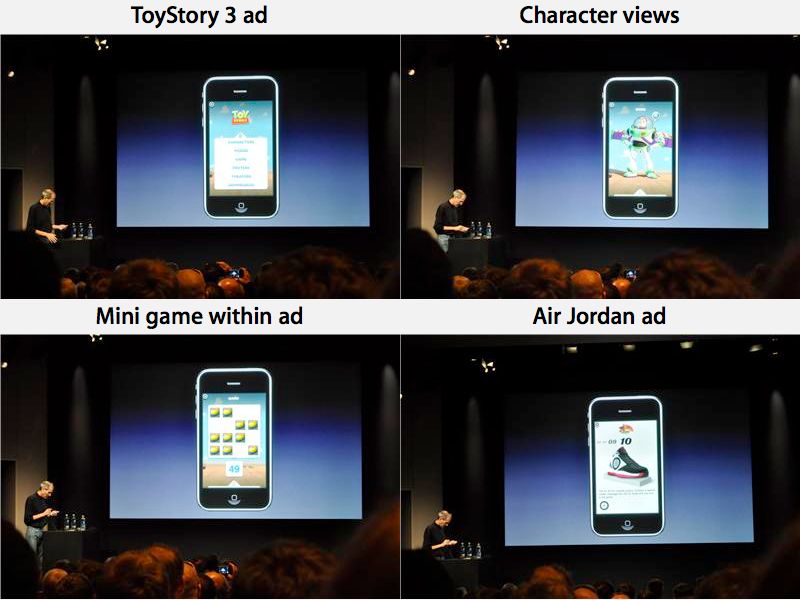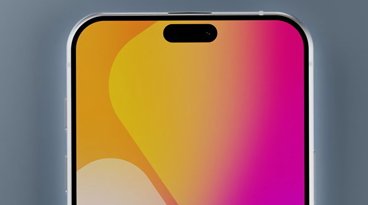Described as "a new form of mobile advertising designed by Apple to deliver the interaction and emotion currently lacking in the mobile space," iAd is conceived to be a way for users to explore rich content ads right within the app that is presenting it, and without being dumped into a web browser.
How mobile ads are different
"If you look at advertisements on a phone, it's not like on a desktop," Jobs explained. "On a desktop, its about search. On mobile, search hasn't happened. People aren't searching on their phones. People are spending their time in apps."
Jobs was alluding to the fact that Google makes nearly all of its revenues from paid search placement on the desktop, not the more familiar banner ads and AdSense links that are more visible on the web. In mobiles however, there's no real market for paid search because people aren't doing lots of searches. They're involved with apps, and so banner ads is all there is, at least for now.
"Developers [who create free apps] need to find a way to start making their money," Jobs said. "A lot of developers turn to advertising - and we think these current advertisements really suck."
During its presentation of the new ad network, chief executive Steve Jobs noted that when you click on existing iPhone mobile ads, it yanks you out of the application you're running and launches a web ad. This prevents people from clicking on ads more often.
In response, Apple has designed a means for providing interactive and video advertising content without ever leaving the app. Apple will sell and host the ads under a 40/60 split, with app developers getting the larger slice of the ad revenue.
HTML5 content (no Flash)
Jobs said ad content would all be rendered in standard HTML5, and could be developed using any tools the ad agency wanted to use. Ads have access to much of the same APIs as apps, including Location Services and some level of accelerometer access. Asked about the prospects of Flash and Java for iPhone 4, Jobs said, "uh, no."
Apple demonstrated an HTML5 ad for Toy Story 3. The ad allows user to view characters, videos, posters and downloads, play sound clips, and even play a self-contained game within the ad. The user can then leave the interactive ad and return to the app they were previously using.
A second ad example for Air Jordan shoes allows users to build custom shoes, view the history of the product, find a nearby store, and even build a custom dorm room, all within the interactive ad experience.
"We don't know much about this advertising thing." Jobs said during the question and answer period following the event. "We tried to buy a company called AdMob, and Google came in and snatched them because they didn't want us to have them. We bought a smaller but still great company called Quattro."
 Prince McLean
Prince McLean







-m.jpg)






 William Gallagher
William Gallagher
 Wesley Hilliard
Wesley Hilliard
 Christine McKee
Christine McKee

 Andrew Orr
Andrew Orr


 Andrew O'Hara
Andrew O'Hara







38 Comments
I wonder what ad models will be available pay per click, page views, conversions etc.
... "Developers [who create free apps] need to find a way to start making their money," Jobs said. ...
This quote is priceless.
Nothing says more about the intentional confusion created between "free" and "free with ads" as this does. I guess the idea that "free" apps might be actually, you know ... free is old fashioned nowadays?
As is the idea that someone might be making and distributing things for "free" that are actually intended simply as free items?
After seeing the Ad demos (granted made by apple just for this purpose) I have to say Apple is bringing Ads to a place that they don't feel like ads anymore, they are small Apps inside of Apps ... this could be very cool. Hey google you watching, oh wait of course you are .
This quote is priceless.
Nothing says more about the intentional confusion created between "free" and "free with ads" as this does. I guess the idea that "free" apps might be actually, you know ... free is old fashioned nowadays?
As is the idea that someone might be making and distributing things for "free" that are actually intended simply as free items?
I thought of the same thing. I hope Apple provides a tag in the App Store that specifies whether an App is paid-by-ads or really free. I don't really like my kids using ad-supported apps-- I'd rather pay a few bucks or find a worse, free app. But sometimes I don't mind using them myself.
I thought of the same thing. I hope Apple provides a tag in the App Store that specifies whether an App is paid-by-ads or really free. I don't really like my kids using ad-supported apps-- I'd rather pay a few bucks or find a worse, free app. But sometimes I don't mind using them myself.
I dunno. Do websites declare themselves in Google searches as to their ad status? Do magazines have badges on their covers to let you know how many and what kind of ads, if any, you'll have to look at (or page past) to get at the "content"? Do the listings for movies clue me in as to whether the theater will be showing ads prior? It just doesn't seem like this idea is much of a common practice, anywhere, so I'm not sure why we should expect if for phone applications (although, don't get me wrong, I would welcome a heads up).
The only place where I could see some kind of notification being absolutely necessary would be if the developer is charging for an app and also including advertising, but my guess is such apps would simply be shunned.